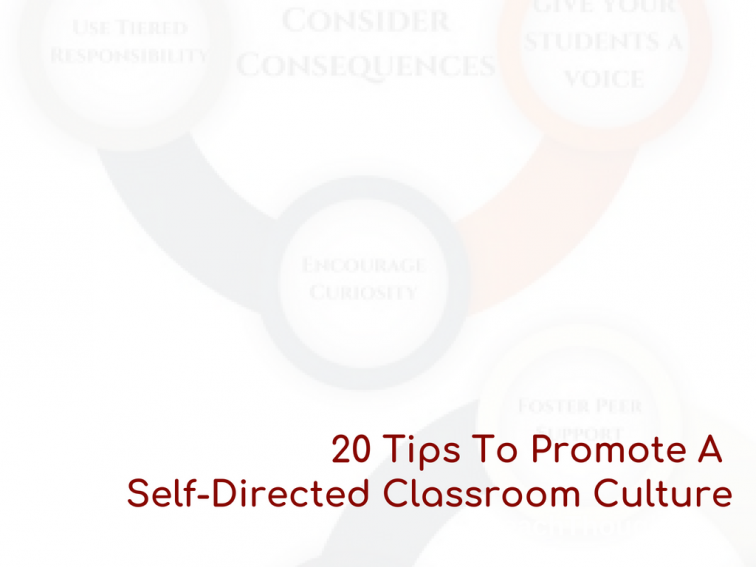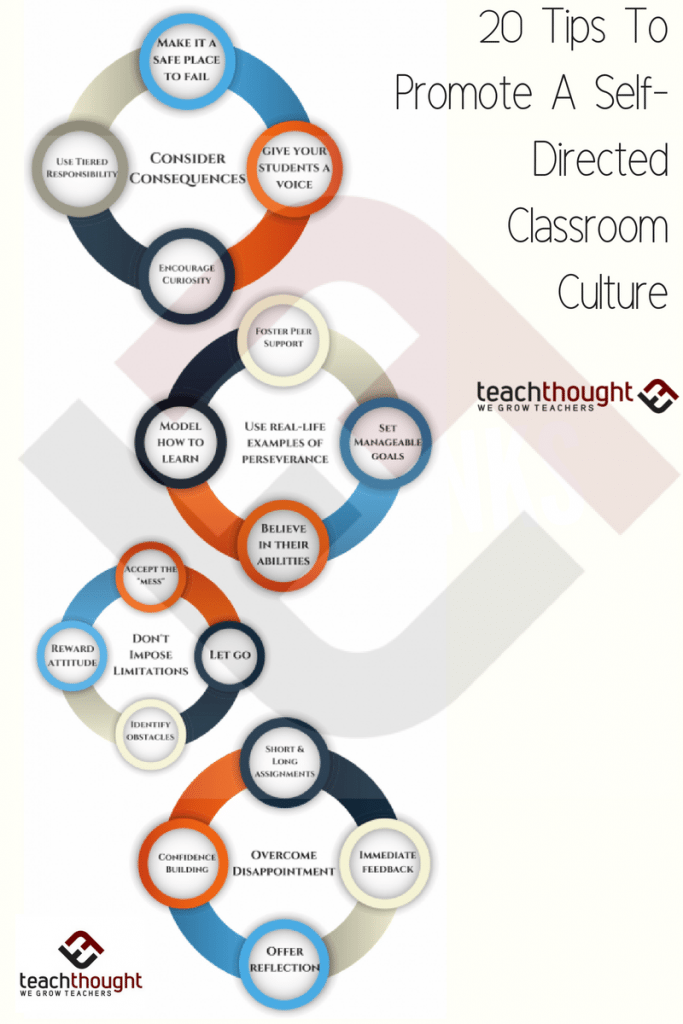
20 Tips To Promote A Self-Directed Classroom Culture
contributed by opencolleges.edu
It’s an age-old saying: “Give a man a fish, and feed him for a day. Teach a man to fish, and feed him for a lifetime.”
What separates good teachers from ‘excellent’ ones? The excellent ones are handing out fishing poles; creating a culture in the classroom of independence and self-reliance. These students don’t just recite facts or regurgitate information- they have learned how to learn. They know that if the answer isn’t in front of them, they have the tools to do the investigation and research.
So how do you cultivate a culture of “I can…” in your classroom?
20 Tips To Promote A Self-Directed Classroom Culture
1. Make It a Safe Place To Fail
The more I study education and psychology, the more convinced I become that failure is one of the most important tools for learning. As children, we try to balance a block on a ball and when it tumbles to the ground, that failure teaches us about the nature of shapes. The next time, we try the block first and then the ball.
Failure can be the doorway to great accidental inventions. We must give our children and students room to fail. The fear of failure cripples a student’s ability to risk new endeavors and try something new. Give them lots of space to mess up and make mistakes. Show them failure is not fatal.
2. Encourage Curiosity
Curiosity is what propels a young child to venture away from the safety of his/her mother to explore the environment. By the time we’re teenagers, a lot of that innate curiosity is squashed through rigorous testing and assignments. As much as possible, allow your student’s curiosity to take them to new places. When assigning projects, do you have to impose limitations on topics or can you trust their curiosity will find something worth investigating?
3. Give Your Students a Voice
Students who have a platform and a voice feel more empowered than those that don’t. Imagine a situation in which you were at work and had no ability to speak your mind or even disagree with a colleague or boss. Would you feel empowered to conquer a big project or would you feel doomed to fail because you couldn’t speak up about your fears, concerns, etc.?
Teaching students how to disagree and debate respectfully helps them to develop their own internal voice – something that is crucial when not everyone is patting you on the back later in life.
4. Use Tiered Responsibility
Terry Heick writes about the Gradual Release of Responsibility Model. In simple terms, it means, “Show me, help me, let me.” As you embark on new subjects, the teacher should first model the concept, then assist the student with the concept, and then let the student work on the concept independently. Each step is critical to allowing the student the chance to trust in his/her ability.
5. Foster Peer Support
Have you ever watched a child who refused to ride a bike for a parent, and then all of a sudden do it when he/she is with a group of friends? Peer support is different than teacher support. Both are necessary.
In the classroom, students who feel ‘I can’ usually have friendships that offer further support when the going gets tough. There is a type of peer pressure that benefits students to complete their assignments. Try to foster that kind of encouragement in your classroom.
6. Consider Natural Consequences
Do you remember the last time you touched a hot oven? You didn’t do it again I’ll bet.
Natural consequences (without condemnation) work well to steer students that need to get back on track. This works closely with creating a place to fail safely. You don’t want to strip students of natural consequences – that isn’t real life. But there is a difference between a situation where the student has to feel the pain of consequences with the help and support of a neutral teacher versus a natural consequence plus a disappointed and angry teacher. It may not work every time, but it might just have a place.
7. Confidence Building
Periodically offer activities that boost confidence. Shower them with praise or arrange a group roasting of one particular individual that is working particularly hard. Do things that help bolster their unique strengths and abilities. Not everyone is a math whiz perhaps, but each student has a talent that should be celebrated.
8. Model How To Learn
Students get a kick out of watching their teacher learn. Most of the time, you are in the position of ‘all-knowing’ instructor. Try exploring a topic together that you all know nothing about. They will carefully observe how you are learning to get ideas for how to do it themselves. If you aren’t overly critical when you fail or mess up, that will stick.
9. Don’t Impose Limitations
Sometimes the assignment limits a student’s possibility. Rather than saying, “Write a five page paper on llamas,” ask them to write as much as they can about their topic. Yes, you’ll have a few students who go way under what you were hoping for, but you might be surprised to see how far some students go when there aren’t any limitations on the goal. Then it gives you the opportunity to say, “Wow! I didn’t realize you could…” and watch their faces light up with confidence and joy.
10. Use Real-Life Examples of Perseverance
Take time out of the day to study other ‘can-do’ leaders. Study people who rose out of hard circumstances, people with crippling disabilities who still went on to beat the odds, and those who failed repeatedly before their big successes. Use interesting stories. Most people don’t know about Abraham Lincoln’s constant depression or the handful of elections he lost prior to becoming president.
11. Teach Students How To Set Manageable Goals
When a task feels overwhelming, the ‘I can,’ quickly falls apart. Teach the art of goal-setting – how to break down a big project into miniature steps. Goals aren’t meant to be benchmarks of success but rather a roadmap to keep you on track.
12. Teach Students How To Overcome Disappointment
Disappointment is one of the biggest reasons people give up. No one likes the feeling of disappointment. It just plain hurts. But it also is real life. If you don’t know how to bounce back after a crushing loss or unmet expectation, you will quit. Overcoming disappointment is the foundation to an ‘I still can’ attitude. When your students face a loss, teach them how to step back and see the bigger picture, feel the loss, talk it out, and then move onward.
See also Alternatives To I Don’t Know And I Can’t
13. Reward Attitude, Not Just Aptitude
Can you imagine a school environment where an attitude of diligence, honesty, perseverance, and positivity were given scores as much as the goal or outcome? Life is 90% attitude, 10% ability. In school, we have it backward. As the teacher, you can create a classroom of attitude, even when you are obligated to produce “results”.
14. Believe In Their Abilities
Ultimately a child must come to believe in his/herself. But before that can happen, someone older and wiser must hedge their bets on that child. As you get to know each of your students, extend great confidence in their blossoming abilities. This is a difficult thing to do when you see a student is struggling in a certain area.
You don’t want to say, “Oh I know you can complete AP calculus,” when they are failing Algebra I. At that point, it’s about instilling in them the belief that they can get through it – no matter what the grade or outcome. As long as they are doing their best, that is what matters.
15. Accept The ‘Mess’
This goes along with the tip above. Learning is messy. Childhood is messy. The whole thing is a big ball of failures and flub-ups, which ultimately produces an adult who has the skills and knowledge to succeed in some area of life. Our classrooms are not to be modeled after manufacturing plants. They should be like garden nurseries. There is growth, but it is messy. Things are not always orderly or in the proper spot, but it is okay.
16. Offer Reflection After The Project Is Over
After a failure or a success, self-reflection is crucial. Ask questions like,
- What part of this was easiest for you?
- What part was most difficult?
- Where do you think you could have worked harder?
- Do you think you could have worried less about…?
- How do you hope next time goes?
- Is there anything you wish you could have told yourself at the beginning of this project?
- Are you proud of your work? Why or why not?
17. Give Immediate Feedback
Grades come at the end of an assignment right? But at that point, it is too late to fix it! The grade acts as a barometer for how a student did. Why not grade the progress each and every day? If at the end of the day, they have a C-, next day there is the chance to bump it up. Daily feedback helps keep students on track.
See also 20 Ways To Provide Effective Feedback For Learning
18. Give Both Short And Long-Term Assignments
Ask a sprinter if they like marathons and they’ll probably shake their head no (vehemently!). Sprinters and marathon runners are both runners, but the training is worlds apart. The same goes for long-term and short-term assignments. Students need to flex muscles of patience and perseverance during long projects. For the short ones, they need concentration and focus.
Keep your assignments varied so they are practicing the emotional muscles needed for each type of project.
19. Identify Obstacles And Negative Beliefs
When a student is stuck, you must put your psychologist hat on for a moment and help him/her to see where negative beliefs and thought patterns cause obstacles to success. Oftentimes we want to blame our circumstances, our lack of ability, lack of time, etc. but the true problem is our mindset.
The biggest obstacles happen between the ears.
20. Let Go Of The Idea That a Student’s Success Reflects On You
It is so much easier to facilitate learning when you aren’t wrapped up in the outcome. I realize this is far easier said than done, in both teaching and parenting. We want to know that our own tactics are producing results. In some cases funding, evaluations, and promotions are dependent on how the class performs.
But there is a fine balance here.
Teachers who are less ’emotionally’ invested in a student’s failure will not get as angry or frustrated when things don’t go as planned. It is easier to develop a safe environment for failing when you are the neutral (but compassionate) supporter, rather than someone who is holding your breath on the outcome of the project. It’s a balance of care and at the same time, a healthy detachment that keeps you free from your own worry and stress.
This post has been republished from an earlier post; this post is a cross-post from opencolleges.edu.au; image attribution flickr user vancouverfilmschool
